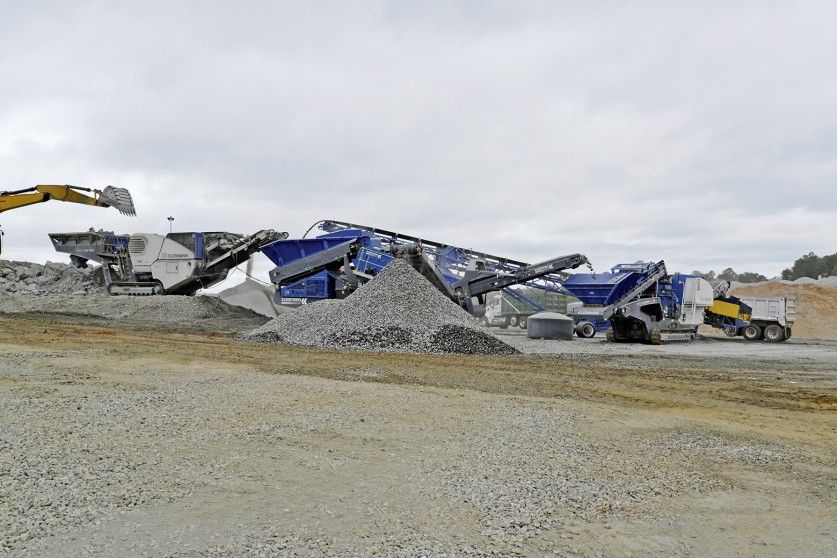Heat of Summer Asphalt Production Equipment
BY AsphaltPro Staff

No one in their right mind would suggest the 2020 construction season has been business-as-usual, but asphalt mix producers have certain protocol that haven’t changed. Quality aggregate washed, screened and sized for tight specs must blend with high-caliber liquid asphalt cement, whether modified or not, to provide paving crews their best chance at success in the field. To help with production from the bottom to the top, original equipment manufacturers (OEMs) have been finding safe and sanitized methods of manufacture, and they’re ready to assist.
The next few pages list some new announcements, products and services OEMs wanted to share with you. Let’s start with a close-up look at the speed of production Riverbend Construction Services, Jefferson City, Tennessee, has enjoyed lately with its new mobile jaw and cone crushers—flanking a new mobile screen. This case study appears courtesy of Kleemann, a division of Wirtgen Group, Antioch, Tennessee.
“Our current business model is to do contract crushing,” said Duff Boyd, president of Riverbend. We focus on mining of construction aggregates and material recycling.”
At an established quarry in South Carolina, Riverbend was taking granite production to a new level that was unattainable by the quarry owner working with its own forces and equipment. There, a new MOBICAT MC 110 Zi EVO primary jaw crusher, a MOBISCREEN MS 15 Z screen, and a MOBICONE MCO 9i EVO secondary cone crusher—all from Kleemann—were working together to smooth production and lower costs.
“Here we are making crusher run granite road base and a No. 4 material, which is 2 inches by 1 ½ inch with no fines,” Boyd said. The crusher run size is 100 percent passing 1 ½ inch all the way down to 200 mesh size. Riverbend does the drilling and blasting of the gray granite, and loads and hauls the raw stone to the processing site on the top of the pit.
The equipment is set up in a closed circuit. Material is primary-crushed at the MC 110 Zi EVO, and both crushed material and all fines go to the mobile screen. The MS 15 Z mobile screen has two decks, the top with 2-inch panels, and 1 ½-inch panels on the bottom deck. The top deck “overs” go to the MCO 9i EVO to be sized down (as the jaw is set to 65 mm, a 4- to 5-inch size rock goes to the cone). The cone crushes that material and sends it back to the screen for resizing. The bottom deck “overs” are a 2 x 1 ½-inch rock, and the bottom deck screen-throughs is a 1 ½-inch size, which is stacked as a product. Anything dropping through is crusher run, which is stockpiled and loaded onto trucks.
With the new equipment, Riverbend was averaging 305 to 335 tons per hour (TPH), depending on the feed.
“If the feed is a good, well-blasted material, with this closed-circuit arrangement, I can easily put up to 340 tph through,” Boyd said. “By well-blasted, I mean a rock that’s not chunky, that’s shot well throughout with some fines in it and a variety of sizes that go into the primary. The moving jaw on the jaw crusher is much longer than the fixed jaw.”
He appreciated that the longer crusher jaw protects the pitman on the jaw crusher and doesn’t give bigger rocks anywhere to catch and hang on. “Kleemann’s taller crusher jaw all but eliminates stoppage due to big rocks. If you are doing 330 tph, and you have to stop for a half hour to dig the rock out, you’ve lost 165 tons of productivity.”
Instead of a grizzly, Boyd’s new MC 110 Zi EVO primary jaw crusher uses an independent prescreen that speeds productivity. “The prescreen pulls all the fines out, and that’s where the tons per hour really pick up,” Boyd said. “But if it’s a coarse material, it all has to go through the jaw and my tons per hour will go down. The prescreen is the ticket. It cuts down on the wear on the crusher jaws and the wear plates. It prevents wear and tear, and increases throughput.
“Currently, we don’t drop any fines through the prescreen that kick out the side; instead, they drop right underneath and bypass the jaw, and we blend and mix them at the MS 15 Z scalping screen,” Boyd said. “When we crush through the MCO 9i EVO, those fines return and we blend the pit fines with the crusher fines to make a more consistent crusher run product, with stable gradation. If we kicked them out at the jaw, and made crusher run at the screen, we’d have two separate products.” The feeder itself sets the feed rate for the tons per hour coming into the plant.
For more information, contact Matt Graves at matt.graves@wirtgen-group.com or visit www.wirtgen-group.com/america.
